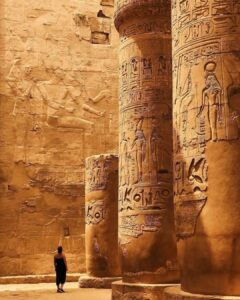Introduction
Nestled in the heart of Luxor, Egypt, the Great Hypostyle Hall of the Temple of Karnak stands as a monumental testament to ancient Egyptian architectural ingenuity and religious devotion. This vast hall is not just a space for worship but also a profound symbol of creation and divinity in ancient Egyptian culture. With its impressive dimensions and intricate designs, the Great Hypostyle Hall continues to captivate visitors and scholars alike.

Architectural Grandeur
Covering an astonishing area of 5,000 m² (54,000 sq ft), the Great Hypostyle Hall was originally designed to impress and inspire. It features 134 colossal columns arranged in 16 rows, creating a forest of stone that invokes a sense of grandeur. The two central rows of columns are particularly noteworthy, reaching heights of 24 meters (79 ft) and boasting circumferences of 10 meters (33 ft). These towering columns were once crowned by a roof that has now fallen, but the hall’s scale and design continue to evoke awe.
Symbolism of Creation
The architectural design of the Great Hypostyle Hall is deeply rooted in the mythology of ancient Egypt. The 134 papyrus columns symbolize the primordial papyrus swamp, from which the self-created deity Atum emerged from the waters of Nun at the beginning of creation. This connection to creation reflects the hall’s purpose as a sacred space where the divine and the earthly intersected. Visitors to the hall would have felt a palpable sense of connection to the mythological narratives that shaped their understanding of the universe.

Historical Context
For many years, scholars believed that the Great Hypostyle Hall was constructed by Pharaohs Horemheb or Amenhotep III. However, recent research has revealed that it was primarily built during the reign of Seti I. Seti I not only oversaw the construction of the hall but also left his mark through intricate inscriptions on the northern wing. These inscriptions showcase religious scenes and reflect the king’s dedication to the gods and the afterlife.
Following Seti I’s contributions, the southern wing of the hall was decorated during the reign of Ramesses II, Seti’s successor and one of Egypt’s most renowned pharaohs. Ramesses II’s embellishments further enhanced the hall’s grandeur and religious significance, solidifying its role as a central place of worship within the Temple of Karnak.
Cultural Significance
The Great Hypostyle Hall is more than just an architectural feat; it embodies the spiritual and cultural ethos of ancient Egypt. The sheer scale and artistry of the hall demonstrate the civilization’s advancements in engineering and artistry, reflecting their values, beliefs, and connection to the divine. The hall’s design served not only functional purposes but also acted as a canvas for religious expression and the commemoration of pharaonic power.

Conclusion
Today, the Great Hypostyle Hall remains one of the most significant and visited sites in Egypt, drawing tourists, historians, and archaeologists from around the globe. Its imposing columns and rich symbolism tell a story of ancient beliefs and practices, offering a glimpse into a civilization that continues to fascinate the modern world. As we explore this magnificent hall, we are reminded of the enduring legacy of ancient Egypt and its profound impact on architecture, religion, and culture. The Great Hypostyle Hall is not just a relic of the past; it is a living testament to humanity’s quest for meaning, connection, and transcendence.
